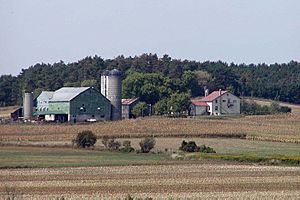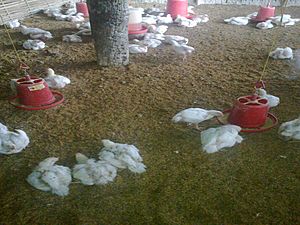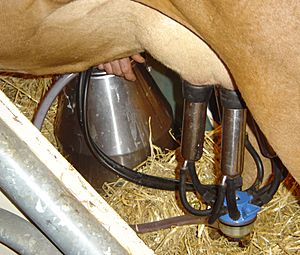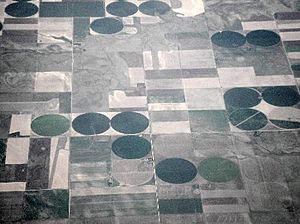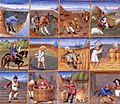Farming facts for kids
Farming is how people grow crops (like fruits and vegetables) or raise animals (like cows and chickens). They do this to get food and other useful things called raw materials. These raw materials can be things like cotton for clothes or wood for building. Farming is a big part of something called agriculture.
Contents
How Farming Started
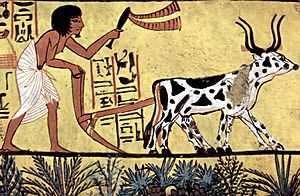
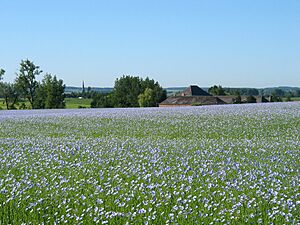
Farming began thousands of years ago, but no one knows exactly when. Before farming, people were mostly hunter-gatherers. They moved around to find food. When farming started, people began to settle down in one place. This led to the creation of villages and later, cities. This big change is sometimes called the Neolithic Revolution.
Farming and taming animals (called domestication) likely started in a place called the Fertile Crescent. This area is in the Middle East, including parts of modern-day Iraq, Syria, Turkey, Jordan, Lebanon, Israel, and Egypt. Some of the first crops grown there were wheat and barley.
People probably started farming slowly. They might have planted a few crops while still gathering food from the wild. Changes in weather or soil might have encouraged them to farm more. Farming allowed many more people to be fed from the same amount of land compared to hunting and gathering.
Different Kinds of Farming
Farming isn't just about growing food. It also includes growing flowers, plants for nurseries, and materials like cotton, wool, and flax for clothes. Farmers also raise animals for their meat, milk, or even their skins (like leather). Some farms even produce biofuels or medicines.
Many people around the world still do subsistence farming. This means they have a small farm and grow just enough food for themselves, their family, and their animals. If they have extra food, they might sell it or trade it for other things they need. The amount of food grown on a piece of land is called the yield. For subsistence farmers, yields are often low.
Sometimes, problems like drought (not enough rain) can cause famines, where there isn't enough food. To get more land, forests are sometimes cut down. This can help in the short term but can harm the environment over many years.
In richer countries, farms are usually much bigger. They produce a lot more food than they used to. This is because farmers use better kinds of plants, more fertilizers, and more water. They also have better ways to control weeds and pests. Many large farms use machines, which means fewer people are needed to do the work.
This type of large-scale farming is called intensive agriculture. It can have some challenges. Farmers might use a lot of chemical fertilizers and pesticides (chemicals that kill bugs). They also use herbicides (chemicals that kill weeds). These chemicals can sometimes pollute the soil or water. They can also lead to bugs and weeds becoming stronger and harder to kill.
The soil itself can be damaged by erosion (when wind or water carries it away). It can also get too much salt or lose its structure. Irrigation (adding water from rivers) can sometimes pollute water or lower the water level underground. However, modern farmers are often well-trained and know how to solve these problems.
Farming Methods
Farmers use different methods to grow healthy crops and raise animals:
- Using Fertilizers to help plants grow.
- Practicing Crop rotation, which means changing the crops grown in a field each season.
- Removing Weeds that compete with crops.
- Careful breeding of plants and animals to get better qualities.
- Ranching for raising livestock like cattle.
Farmers choose plants that grow more food, taste better, and are more nutritious. They also pick plants that can survive diseases and dry weather. Over many years, farmers have used artificial selection to make crops much better. This means they choose the best plants to grow new seeds from.
Some companies use genetic engineering to create new plants. This involves changing a plant's genes to make it stronger or resistant to certain chemicals. For example, a plant might be changed to resist a herbicide.
Food and Farming
It's important that there is enough food for everyone and that it is safe to eat. Some people worry that intensive farming uses too many chemicals. Others are concerned about how it affects the environment. Because of these concerns, there are different ways of farming:
- Traditional agriculture is common in poorer countries. It often involves small farms and less machinery.
- Intensive agriculture is used in richer countries. It uses machines, chemical fertilizers, and pesticides to produce a lot of food.
- Organic farming uses only natural products like compost (rotting plants) and natural fertilizers. It avoids man-made chemicals.
- Integrated farming tries to use local resources and turn waste from one part of the farm into something useful for another part.
Governments often have an Agricultural policy. This means they set goals for how food should be grown. Common goals include:
- Food safety: Making sure the food supply is safe to eat.
- Food security: Making sure there is enough food for everyone.
- Food quality: Making sure the food is good and healthy.
Challenges in Farming
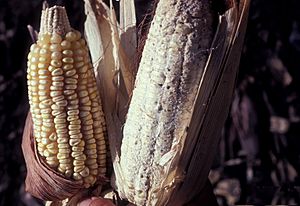
Farmers face many challenges when trying to grow food. These can include:
- Erosion: When valuable soil is washed or blown away.
- Diseases: Plant or animal illnesses that can harm crops or livestock.
- Pests: Insects or other animals that eat or damage crops.
- Weeds: Unwanted plants that grow among crops and steal nutrients.
- Drought: Long periods with little or no rain.
- Too much or too little rainfall.
Important Crops
In 2002, the most important crops grown around the world were maize (corn), wheat, rice, and cotton.
- Maize (corn): 624 million metric tons
- Wheat: 570 million metric tons
- Rice: 381.1 million metric tons
- Cotton: 96.5 million metric tons
See also: List of vegetables, List of herbs, List of fruit
Related Pages
- Aquaculture (farming in water)
- Bee keeping
- Animal husbandry (raising animals)
- Native American agriculture and food
Images for kids
-
Reindeer herding is a type of farming for some people in cold northern areas.
-
Harvesting wheat with a large machine called a combine harvester.
-
Slash and burn farming in Thailand, where forests are cut and burned to clear land.
-
Intercropping of coconut trees and Mexican marigold flowers, growing different crops together.
-
Tilling a field with a tractor to prepare the soil for planting.
-
Genetically modified potato plants (left) that can fight off viruses, unlike normal plants (right).
-
Water pollution in a stream in New Zealand, caused by runoff from farms.
-
A farm machine that turns waste from plants and animals into biogas fuel.
-
Spraying a crop with a pesticide to protect it.
-
Terraces and other methods that help reduce soil erosion and water pollution on a farm in Iowa.
-
A cotton picker machine, which can do the work of many farm workers.
-
A meeting in 1846 against the protectionist Corn Laws in Britain, which made food prices high.
-
An agronomist (a scientist who studies crops) mapping a plant's genome (its genetic information).
See also
 In Spanish: Agricultura para niños
In Spanish: Agricultura para niños


